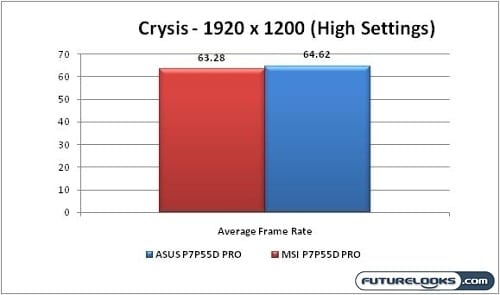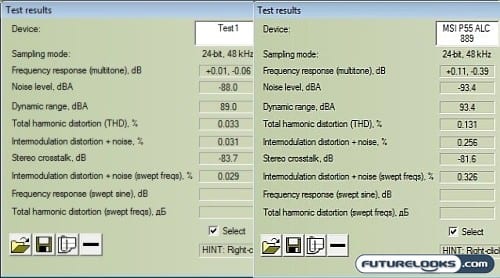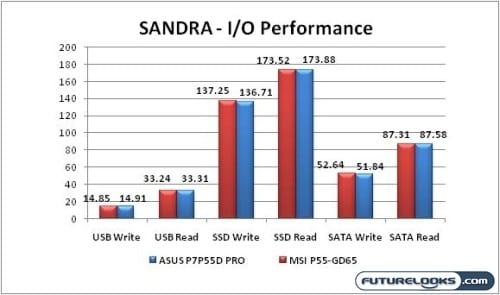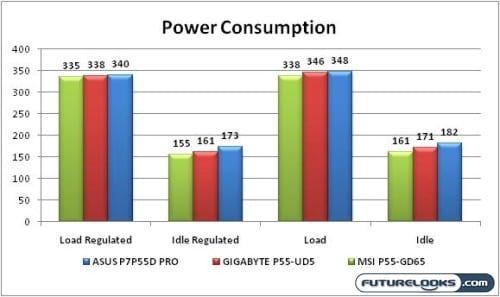Crysis

The ASUS board pulls away in a slight lead in Crysis. It appears this platform has a little something extra to offer. Of course, we’re talking a matter of a frame and some change. Nonetheless, this is very important to die hard gamers that are chronic frame counters.
RightMark Audio
Testing has been kind of eventful as of late. It’s interesting to see how audio Codecs differ in performance. Sometimes we can blame performance faults on drivers while other times it’s the Codec itself like what we found with the recent testing of the Realtek ALC889 and ALC889A. Thus far, that single “A” has been earned as far as integrated audio is concerned.
The ASUS P7P55D PRO breaks away from the pack and integrates a VIA Vinyl HD Codec. This is the first time I’ve had the opportunity to look at a VIA Vinyl audio solution. One of the benefits in favor of the Vinyl Codec is the lower CPU overhead. Neither of the Codecs tested here required or consumed more than 9% of the CPU at the most. This isn’t enough to be of concern to a quad core processor, but this could be important to dual core users.

Referreing to the screenshot above, you can see what RMAA had to say about the two rivals. These results are very similar to the recently benchmarked Realtek ALC889 found on the MSI P55-GD65 which offered noticeable lack luster audio results in both recording and playback as well as contained a bit more noise. However, only half the problem plagues the Vinyl HD Codec.
While recording is of equally low quality, regular playback and general audio experiences is noticeably richer. It doesn’t quite match the depth of the ALC889A found on the GIGABYTE GA-55-UD5, but does come close. So, in this respect, we see the Vinyl’s limits but they shouldn’t be an issue if playback performance is the only thing you are concerned about. If the motherboard offered a Vinyl Envy Codec, the story would be very different. This should give engineers something to think about in the future.
SiSoft SANDRA IO Tests

As with audio Codecs, many little things can differ on two otherwise similarly INTEL chipset equipped boards based on P55, but you have to look for them and most of the time, synthetic benchmarks don’t tell you these things. Although we notice more or less similar performance across the board, there is one strange anomaly where write speeds on SATA with both an SSD (-0.54 MB/s) and conventional platter drive (-0.8 MB/s) were lower on the ASUS board.
This didn’t manifest itself in the PCMark Vantage HDD section since results were tight, but when put under a microscope, there it is.
Power Consumption

Now that we have a good selection of boards to compare, it was time to check one more thing that may differentiate these seemingly similar boards. I blame the high consumption numbers on the GTX 295 once the system gets going full load. Using the various system’s power management software results in a little better power efficiency. It’s not earth shattering, but it’s better than nothing. Plus, it all adds up over the months and years.
After checking the results, it does appear that the MSI wins the day in the Eco-Friendly category with the GIGABYTE closing in on second. The worst of the bunch unfortunately is the ASUS.
